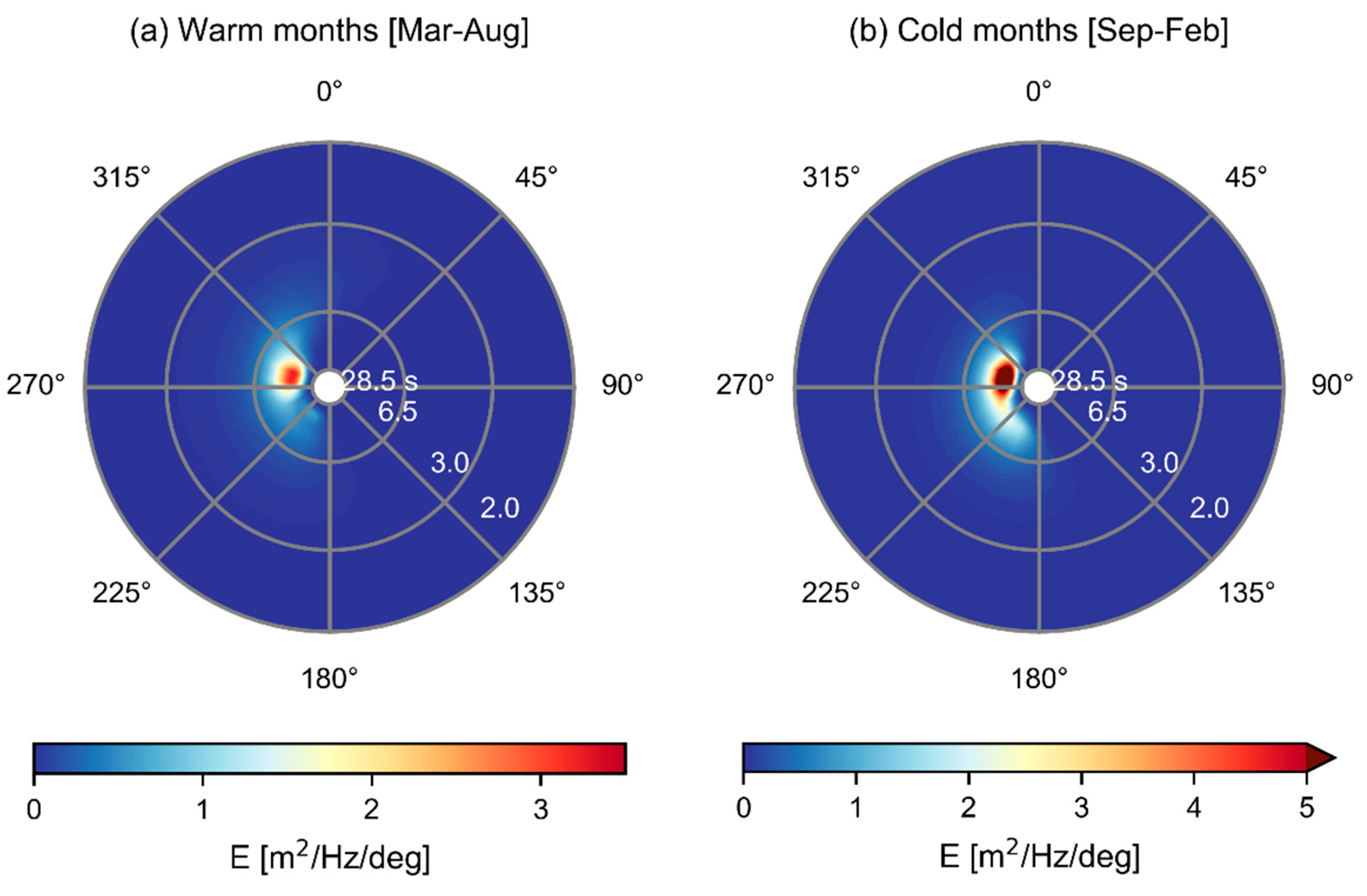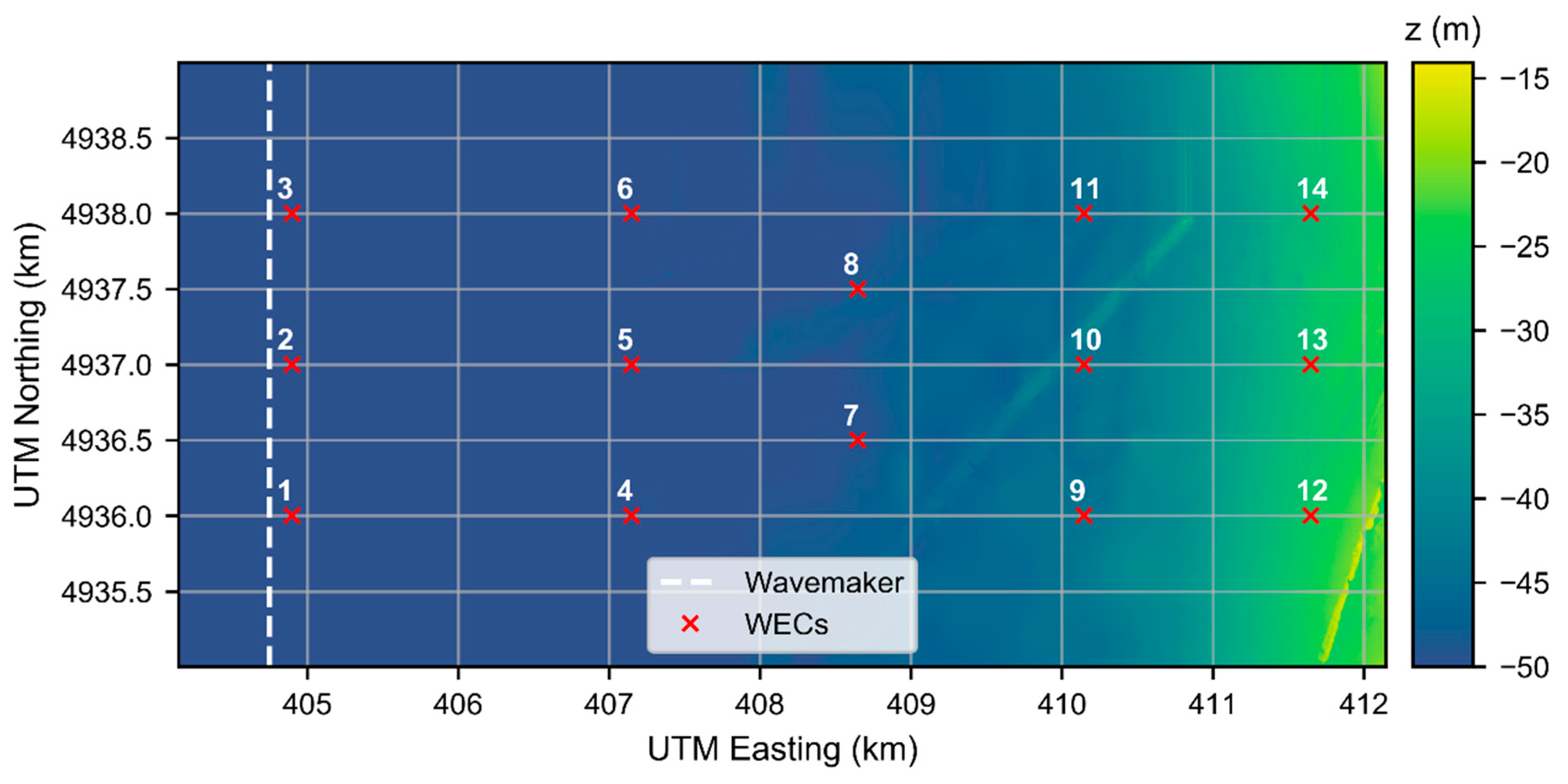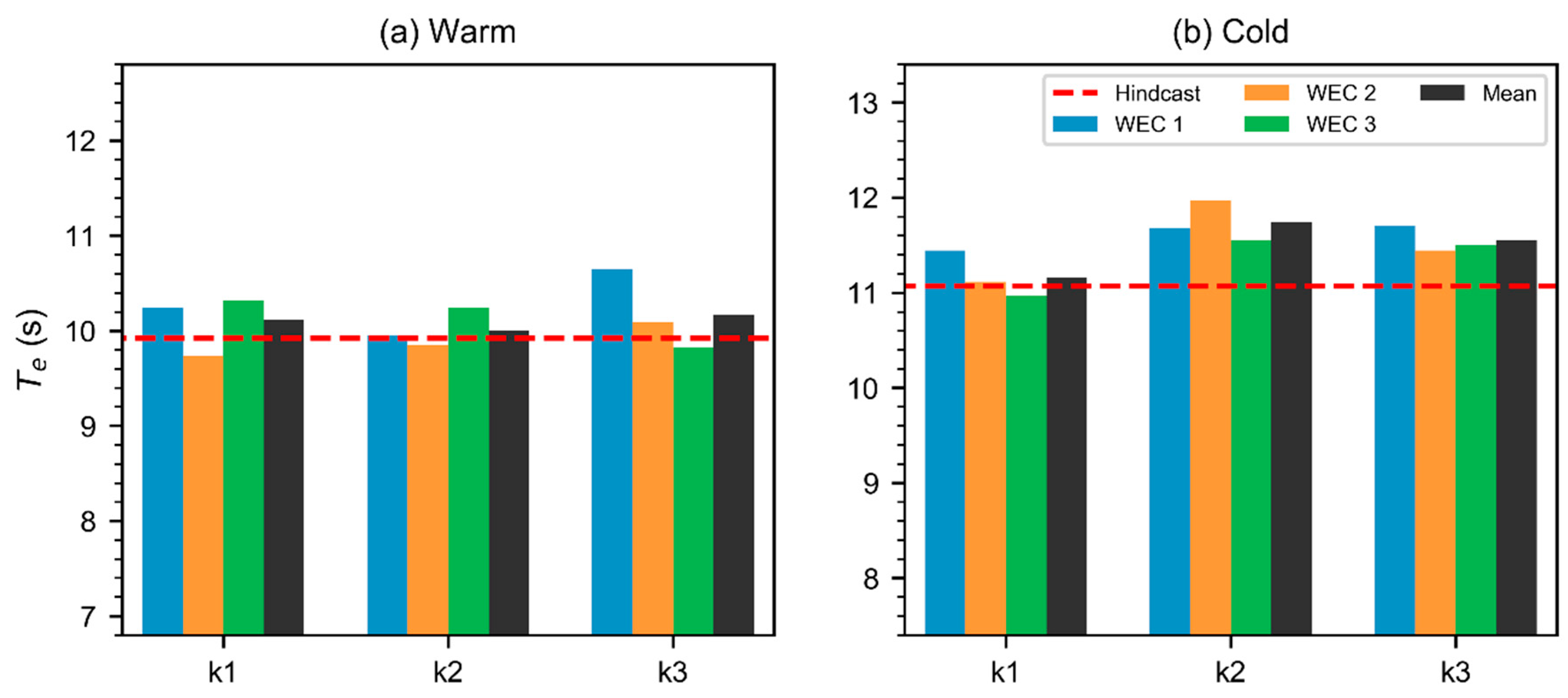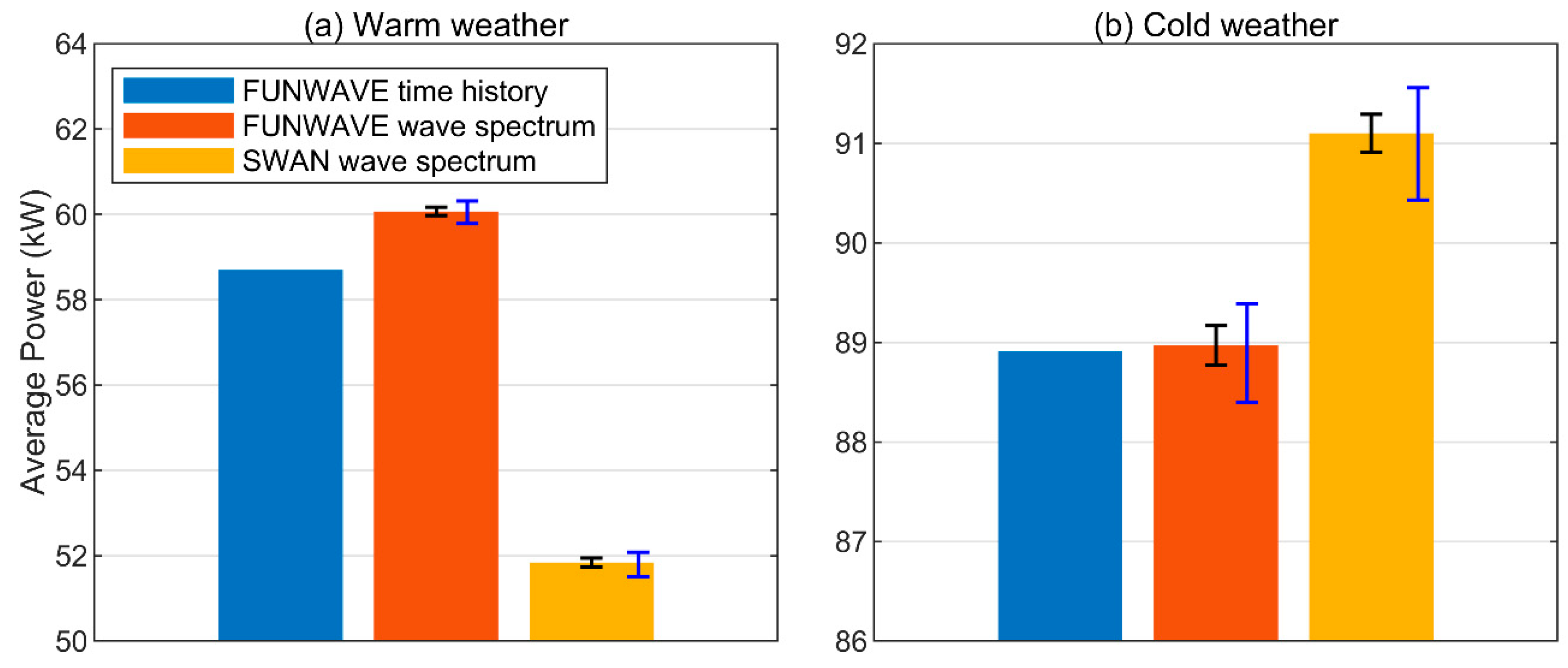Influence of Time and Frequency Domain Wave Forcing on the Power Estimation of a Wave Energy Converter Array
Abstract
:1. Introduction
2. Materials and Methods
2.1. Study Site
2.2. Configuration of Wave Models
2.2.1. SWAN
2.2.2. FUNWAVE
2.3. WEC-Sim Model Configuration
3. Results
3.1. FUNWAVE Model Performance
3.2. WEC Dynamics and Power Output
4. Summary and Discussion
Author Contributions
Funding
Acknowledgments
Conflicts of Interest
References
- Muljadi, E.; McKenna, H.E. Power quality issues in a hybrid power system. IEEE Trans. Ind. Appl. 2002, 38, 803–809. [Google Scholar] [CrossRef]
- Stefek, J.; Bain, D.; Yu, Y.-H.; Jenne, D.; Stark, G. Analysis on the Influence of an Energy Storage System and Its Impact to the Grid for a Wave Energy Converter. In Proceedings of the 38th International Conference on Ocean, Offshore and Arctic Engineering (OMAE 2019), Glasgow, Scotland, UK, 9–14 June 2019. [Google Scholar]
- Parwal, A.; Fregelius, M.; Temiz, I.; Göteman, M.G.; De Oliveira, J.; Boström, C.; Leijon, M. Energy management for a grid-connected wave energy park through a hybrid energy storage system. Appl. Energy 2018, 231, 399–411. [Google Scholar] [CrossRef]
- Blavette, A.; O’Sullivan, D.L.; Lewis, A.W.; Egan, M.G. Impact of a wave farm on its local grid: Voltage limits, flicker level and power fluctuations. In Proceedings of the 2012 Oceans—Yeosu, Yeosu, Korea, 21–24 May 2012; pp. 1–9. [Google Scholar]
- Sjolte, J.; Tjensvoll, G.; Molinas, M. Power Collection from Wave Energy Farms. Appl. Sci. 2013, 3, 420–436. [Google Scholar] [CrossRef]
- Folley, M.; Babarit, A.; Child, B.; Forehand, D.; O’Boyle, L.; Silverthorne, K.; Spinneken, J.; Stratigaki, V.; Troch, P. A Review of Numerical Modelling of Wave Energy Converter Arrays. In Proceedings of the 31st International Conference on Offshore Mechanics and Arctic Engineering (OMAE 2012), Rio de Janeiro, Brazil, 1–6 July 2012; Volume 7, pp. 535–545. [Google Scholar]
- Chang, G.; Ruehl, K.; Jones, C.A.; Roberts, J.; Chartrand, C. Numerical modeling of the effects of wave energy converter characteristics on nearshore wave conditions. Renew. Energy 2016, 89, 636–648. [Google Scholar] [CrossRef] [Green Version]
- Atan, R.; Finnegan, W.; Nash, S.; Goggins, J. The effect of arrays of wave energy converters on the nearshore wave climate. Ocean Eng. 2019, 172, 373–384. [Google Scholar] [CrossRef]
- Cruz, J.; Mackay, E.; Livingstone, M.; Child, B. Validation of design and planning tools for wave energy converters (WECs). In Proceedings of the 1st Marine Energy Technology Symposium, Washington, DC, USA, 10–11 April 2013. [Google Scholar]
- Folley, M.; Whittaker, T.J.T. The effect of sub-optimal control and the spectral wave climate on the performance of wave energy converter arrays. Appl. Ocean Res. 2009, 31, 260–266. [Google Scholar] [CrossRef]
- Folley, M. Numerical Modelling of Wave Energy Converters: State-of-the-Art Techniques for Single Devices and Arrays; 2016; ISBN 978-0-12-803210-7. [Google Scholar] [CrossRef] [Green Version]
- Wei, Y.; Abadie, T.; Dias, F. A Cost-Effective Method for Modelling Wave-OWSC Interaction. Int. J. Offshore Polar Eng. 2017, 27, 366–373. [Google Scholar] [CrossRef]
- Beels, C.; Troch, P.; De Backer, G.; Vantorre, M.; De Rouck, J. Numerical implementation and sensitivity analysis of a wave energy converter in a time-dependent mild-slope equation model. Coast. Eng. 2010, 57, 471–492. [Google Scholar] [CrossRef]
- Mendoza, E.; Silva, R.; Zanuttigh, B.; Angelelli, E.; Lykke Andersen, T.; Martinelli, L.; Nørgaard, J.Q.H.; Ruol, P. Beach response to wave energy converter farms acting as coastal defence. Coast. Eng. 2014, 87, 97–111. [Google Scholar] [CrossRef]
- Balitsky, P.; Verao Fernandez, G.; Stratigaki, V.; Troch, P. Assessment of the Power Output of a Two-Array Clustered WEC Farm Using a BEM Solver Coupling and a Wave-Propagation Model. Energies 2018, 11, 2907. [Google Scholar] [CrossRef] [Green Version]
- Venugopal, V.; Smith, G.H. Wave Climate Investigation for an Array of Wave Power Devices. In Proceedings of the 7th European Wave and Tidal Energy Conference, Porto, Portugal, 11–14 September 2007; p. 10. Available online: https://tethys.pnnl.gov/publications/wave-climate-investigation-array-wave-power-devices (accessed on 15 September 2019).
- Shi, F.; Kirby, J.T.; Harris, J.C.; Geiman, J.D.; Grilli, S.T. A high-order adaptive time-stepping TVD solver for Boussinesq modeling of breaking waves and coastal inundation. Ocean Model. 2012, 43–44, 36–51. [Google Scholar] [CrossRef]
- Angelis-Dimakis, A.; Biberacher, M.; Dominguez, J.; Fiorese, G.; Gadocha, S.; Gnansounou, E.; Guariso, G.; Kartalidis, A.; Panichelli, L.; Pinedo, I.; et al. Methods and tools to evaluate the availability of renewable energy sources. Renew. Sustain. Energy Rev. 2011, 15, 1182–1200. [Google Scholar] [CrossRef]
- Yu, Y.-H.; Lawson, M.; Ruehl, K.; Michelen, C. Development and Demonstration of the WEC-Sim Wave Energy Converter Simulation Tool. In Proceedings of the 2nd Marine Energy Technology Symposium, Seattle, WA, USA, 15–18 April 2014. [Google Scholar]
- NOAA National Centers for Environmental Information; NOAA Center for Tsunami Research Central Oregon Coastal Digital Elevation Model NAVD 88. Natl. Cent. Environ. Inf. NESDIS NOAA US Dep. Commer. 2015. Available online: https://data.nodc.noaa.gov/cgi-bin/iso?id=gov.noaa.ngdc.mgg.dem:11500 (accessed on 15 September 2019).
- Babarit, A. On the park effect in arrays of oscillating wave energy converters. Renew. Energy 2013, 58, 68–78. [Google Scholar] [CrossRef] [Green Version]
- García-Medina, G.; Özkan-Haller, H.T.; Ruggiero, P. Wave resource assessment in Oregon and southwest Washington, USA. Renew. Energy 2014, 64, 203–214. [Google Scholar] [CrossRef]
- Ruggiero, P.; Komar, P.D.; Allan, J.C. Increasing wave heights and extreme value projections: The wave climate of the U.S. Pacific Northwest. Coast. Eng. 2010, 57, 539–552. [Google Scholar] [CrossRef]
- Wu, W.-C.; Wang, T.; Yang, Z.; García-Medina, G. Development and validation of a high-resolution regional wave hindcast model for U.S. West Coast wave resource characterization. Renew. Energy 2020, 152, 736–753. [Google Scholar] [CrossRef]
- Booij, N.; Ris, R.C.; Holthuijsen, L.H. A third-generation wave model for coastal regions: 1. Model description and validation. J. Geophys. Res. Oceans 1999, 104, 7649–7666. [Google Scholar] [CrossRef] [Green Version]
- Allahdadi, M.N.; Gunawan, B.; Lai, J.; He, R.; Neary, V.S. Development and validation of a regional-scale high-resolution unstructured model for wave energy resource characterization along the US East Coast. Renew. Energy 2019, 136, 500–511. [Google Scholar] [CrossRef]
- Li, N.; Cheung, K.F.; Stopa, J.E.; Hsiao, F.; Chen, Y.-L.; Vega, L.; Cross, P. Thirty-four years of Hawaii wave hindcast from downscaling of climate forecast system reanalysis. Ocean Model. 2016, 100, 78–95. [Google Scholar] [CrossRef] [Green Version]
- Robertson, B.R.D.; Hiles, C.E.; Buckham, B.J. Characterizing the near shore wave energy resource on the west coast of Vancouver Island, Canada. Renew. Energy 2014, 71, 665–678. [Google Scholar] [CrossRef]
- Yang, Z.; Neary, V.S.; Wang, T.; Gunawan, B.; Dallman, A.R.; Wu, W.-C. A wave model test bed study for wave energy resource characterization. Renew. Energy 2017, 114, 132–144. [Google Scholar] [CrossRef]
- Marine Energy—Wave, Tidal and Other Water Current Converters—Part 101: Wave Energy Resource Assessment and Characterization; International Electrotechnical Commission: Geneva, Switzerland, 2015; pp. 1–53.
- Shi, F.; Kirby, J.T.; Tehranirad, B.; Harris, J.C.; Choi, Y.-K.; Malej, M. FUNWAVE-TVD, Fully Nonlinear Boussinesq Wave Model with TVD Solver, Documentation and User’s Manual (Version 3.0); Center for Applied Coastal Research, University of Delaware: Newark, DE, USA, 2016. [Google Scholar]
- Nwogu, O. Alternative Form of Boussinesq Equations for Nearshore Wave Propagation. J. Waterw. Port Coast. Ocean Eng. 1993, 119, 618–638. [Google Scholar] [CrossRef] [Green Version]
- Chen, Q.; Kirby, J.T.; Dalrymple, R.A.; Shi, F.; Thornton, E.B. Boussinesq modeling of longshore currents. J. Geophys. Res. Oceans 2003, 108. [Google Scholar] [CrossRef]
- Chen, Q. Fully Nonlinear Boussinesq-Type Equations for Waves and Currents over Porous Beds. J. Eng. Mech. 2006, 132, 220–230. [Google Scholar] [CrossRef]
- Kennedy, A.B.; Kirby, J.T.; Chen, Q.; Dalrymple, R.A. Boussinesq-type equations with improved nonlinear performance. Wave Motion 2001, 33, 225–243. [Google Scholar] [CrossRef]
- Wei, G.; Kirby, J.T.; Sinha, A. Generation of waves in Boussinesq models using a source function method. Coast. Eng. 1999, 36, 271–299. [Google Scholar] [CrossRef]
- Chawla, A.; Kirby, J.T. A source function method for generation of waves on currents in Boussinesq models. Appl. Ocean Res. 2000, 22, 75–83. [Google Scholar] [CrossRef]
- Suanda, S.H.; Perez, S.; Feddersen, F. Evaluation of a source-function wavemaker for generating random directionally spread waves in the sea-swell band. Coast. Eng. 2016, 114, 220–232. [Google Scholar] [CrossRef] [Green Version]
- Grassa, J.M. Directional random waves propagation on beaches. Coast. Eng. Proc. 1990, 1. [Google Scholar]
- Cummins, W.E. The Impulse Response Function and Ship Motions. In Proceedings of the Symposium on Ship Theory, Hamburg, Germany, 25–27 January 1962; pp. 1–9. [Google Scholar]
- Neary, V.S.; Previsic, M.; Jepsen, R.A.; Michael, J.L.; Yu, Y.-H.; Copping, A.E.; Fontaine, A.A.; Hallett, K.C.; Murray, D.K. Methodology for Design and Economic Analysis of Marine Energy Conversion (MEC) Technologies; Sandia National Laboratories: Albuquerque, NM, USA; Livermore, CA, USA, 2004. [Google Scholar]
- Yu, Y.-H.; Tom, N.; Jenne, D. Numerical Analysis on Hydraulic Power Take-Off for Wave Energy Converter and Power Smoothing Methods. In Proceedings of the 37th International Conference on Ocean, Offshore and Arctic Engineering (OMAE 2018), Madrid, Spain, 17–22 June 2018; p. V010T09A043. [Google Scholar]















| Input Wave Product | Realizations (Per Season) | Data Points | Temporal Setup | Spatial Coverage |
|---|---|---|---|---|
| 2D seasonal spectra for warm & cold months | k1 k2 k3 | WECs 1 thru 14 | 2100 s record length 0.1-s resolution | 4 km N-S, 8 km W-E 2.0-m resolution |
| Body | Center of Gravity (m) | Mass (103 kg) | Moment of Inertia (103 kg m2) | ||
|---|---|---|---|---|---|
| Ixx | Iyy | Izz | |||
| Float | [0, 0, −0.72] | 727.01 | 20,900 | 21,300 | 37,000 |
| Spar/Plate | [0, 0, −21.29] | 878.30 | 137,000 | 137,000 | 28,500 |
© 2020 by the authors. Licensee MDPI, Basel, Switzerland. This article is an open access article distributed under the terms and conditions of the Creative Commons Attribution (CC BY) license (http://creativecommons.org/licenses/by/4.0/).
Share and Cite
Ticona Rollano, F.; Tran, T.T.; Yu, Y.-H.; García-Medina, G.; Yang, Z. Influence of Time and Frequency Domain Wave Forcing on the Power Estimation of a Wave Energy Converter Array. J. Mar. Sci. Eng. 2020, 8, 171. https://doi.org/10.3390/jmse8030171
Ticona Rollano F, Tran TT, Yu Y-H, García-Medina G, Yang Z. Influence of Time and Frequency Domain Wave Forcing on the Power Estimation of a Wave Energy Converter Array. Journal of Marine Science and Engineering. 2020; 8(3):171. https://doi.org/10.3390/jmse8030171
Chicago/Turabian StyleTicona Rollano, Fadia, Thanh Toan Tran, Yi-Hsiang Yu, Gabriel García-Medina, and Zhaoqing Yang. 2020. "Influence of Time and Frequency Domain Wave Forcing on the Power Estimation of a Wave Energy Converter Array" Journal of Marine Science and Engineering 8, no. 3: 171. https://doi.org/10.3390/jmse8030171
APA StyleTicona Rollano, F., Tran, T. T., Yu, Y.-H., García-Medina, G., & Yang, Z. (2020). Influence of Time and Frequency Domain Wave Forcing on the Power Estimation of a Wave Energy Converter Array. Journal of Marine Science and Engineering, 8(3), 171. https://doi.org/10.3390/jmse8030171







